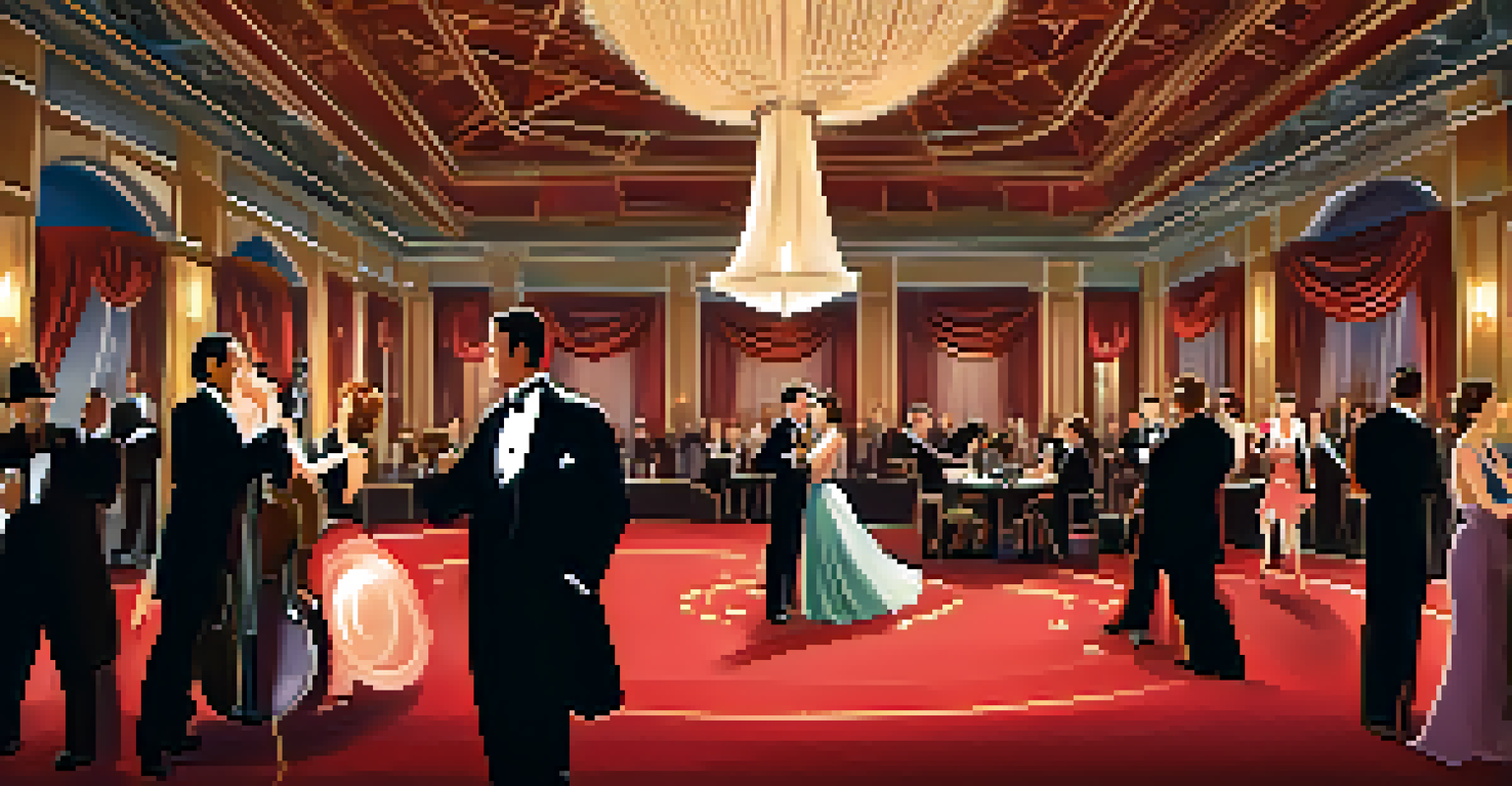Exploring Adaptations: Literature's Influence on Hollywood Films

The Deep Connection Between Literature and Film
Literature and film share a rich, intertwined history that goes back decades. Novels, plays, and short stories often serve as the backbone of Hollywood scripts, providing filmmakers with rich narratives. This connection allows for a deeper exploration of themes and characters that resonate with audiences across different mediums.
Books are a uniquely portable magic.
When a beloved book is adapted into a film, it’s not just a transfer of story; it’s a reinterpretation that invites fresh perspectives. For example, many viewers flock to adaptations like 'The Great Gatsby' or 'Pride and Prejudice,' eager to see how their favorite characters come to life on screen. These adaptations often spark renewed interest in the original texts, creating a cyclical relationship between the two forms.
Moreover, adaptations allow filmmakers to explore visual storytelling in ways that words might not convey. The way a scene is shot, the music that accompanies it, and the performances of the actors can add layers of meaning that enrich the original narrative. This synergy between literature and cinema continues to captivate audiences worldwide.
Transforming Characters: From Page to Screen
One of the most fascinating aspects of literary adaptations is how characters are transformed for the screen. While some filmmakers stay true to the source material, others take creative liberties to modernize or reinterpret characters. For instance, in the adaptation of 'The Hunger Games,' Katniss Everdeen's character is brought to life with a fierce independence that resonates with contemporary audiences.

These character transformations can lead to diverse interpretations, sparking discussions among fans about the faithfulness of the adaptation. A notable example is the reinterpretation of Captain Ahab in 'Moby Dick' — while the novel presents a complex, obsessive figure, various films have portrayed him with different shades of madness. Such variations highlight how adaptations can reflect societal values and changes over time.
Literature Inspires Film Adaptations
Novels and plays often serve as the foundation for films, allowing for deeper exploration of themes and characters.
Ultimately, these character adaptations contribute to a richer cinematic experience, allowing viewers to connect with the characters on a different level. They can provoke new thoughts and feelings, making the story relevant to a new generation, which adds to the ongoing dialogue between literature and film.
Plot Changes: Why Adaptations Deviate
Not all adaptations stick closely to the original plot, and that’s often by design. Filmmakers may choose to change plot points to maintain pacing, enhance dramatic tension, or appeal to a broader audience. For example, in 'The Shining,' Stanley Kubrick made significant changes to Stephen King's original story, focusing more on psychological horror than supernatural elements.
The cinema is not a slice of life, but a piece of cake.
These deviations can also stem from practical considerations, such as time constraints or budget limitations. Certain subplots that work well in a novel may feel extraneous in a movie, leading to their omission. This streamlining can sometimes frustrate purists but often results in a tighter, more engaging narrative for viewers.
Adaptations that take creative liberties can also lead to surprising outcomes and unexpected twists, keeping audiences on their toes. This unpredictability is part of what makes adaptations exciting, as they can introduce fresh elements while still paying homage to the original tale.
Visual Storytelling: The Power of Cinematic Techniques
One of the most compelling aspects of adapting literature into film is the opportunity for visual storytelling. Cinematic techniques such as lighting, camera angles, and special effects can elevate a story’s emotional impact. Consider how the hauntingly beautiful visuals in 'Life of Pi' brought Yann Martel's words to life, creating a mesmerizing experience for viewers.
In many cases, filmmakers use visual metaphors to convey themes that may be explicitly stated in the text. This layer of interpretation can deepen the audience's understanding and engagement with the story. For example, the use of color palettes in 'The Great Gatsby' reflects the opulence and tragedy of the characters' lives, enhancing the emotional resonance of the narrative.
Character Transformations in Adaptations
Filmmakers reinterpret characters for the screen, which can lead to diverse interpretations and provoke discussions among fans.
These techniques also allow filmmakers to explore character emotions in ways that written descriptions might not capture. A simple close-up of a character's face can convey a world of feelings, drawing the audience into their psychological landscape. This integration of visual elements is a testament to the collaborative nature of storytelling across different forms.
Cultural Context: Literature’s Reflection of Society
Literary works often reflect the cultural and social issues of their time, making them ripe for adaptation. By bringing these texts to the screen, filmmakers can spark conversations about relevant themes that continue to resonate today. Take 'To Kill a Mockingbird,' for instance; its exploration of racial injustice remains impactful in modern cinema.
When these stories are adapted, they can be recontextualized to address contemporary issues. For example, the film adaptation of 'The Handmaid's Tale' gained renewed attention as discussions about women's rights and social justice became increasingly relevant. This ability to adapt and reflect current societal concerns is a powerful tool for filmmakers.
Moreover, adaptations can introduce classic literature to new audiences, ensuring that these important narratives continue to be discussed and appreciated. By bridging the gap between past and present, adaptations play a crucial role in keeping literary voices alive in the collective consciousness.
The Audience Experience: Reading vs. Watching
The experience of consuming literature differs significantly from watching its film adaptation. Reading allows for personal interpretation and imagination, where each reader visualizes characters and settings uniquely. In contrast, films present a specific vision that can either align with or diverge from a viewer's imagination.
This difference can lead to varying degrees of satisfaction among audiences. Some may find that a film adaptation enhances their understanding of the book, while others might feel disappointed if the film doesn't capture the essence of the original story. For instance, many fans of 'Harry Potter' have debated the changes made in the films, often expressing nostalgia for the details left behind.
Visual Techniques Enhance Storytelling
Cinematic techniques, such as lighting and camera angles, elevate the emotional impact of stories, making literature come alive on screen.
Despite these differences, both mediums offer valuable experiences. Literature invites introspection and deep engagement, while film provides a communal experience that can foster discussions among viewers. Ultimately, both forms enrich our understanding of stories and characters in their unique ways.
The Future of Adaptations: Trends and Innovations
As we look to the future, the landscape of adaptations is evolving with new trends and innovations. Streaming platforms have democratized access to diverse literary works, leading to an increase in adaptations of lesser-known texts. This shift allows for fresh stories and voices to emerge, expanding the scope of what adaptations can be.
Furthermore, advancements in technology are enabling filmmakers to create more immersive experiences. Virtual reality and interactive storytelling are beginning to influence how stories are adapted, providing audiences with unprecedented engagement. Imagine stepping into the world of a novel, making choices that shape the narrative as you go — this could redefine the adaptation experience.

As the line between literature and film continues to blur, audiences can anticipate more innovative and diverse adaptations. This evolution not only enriches our cultural landscape but also invites us to explore familiar stories in new and exciting ways, ensuring that the relationship between literature and film remains dynamic and ever-evolving.